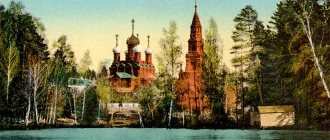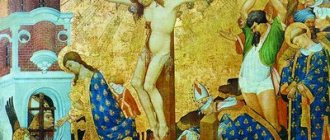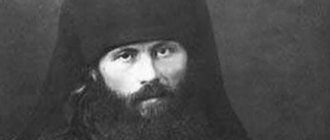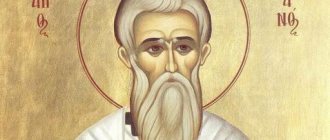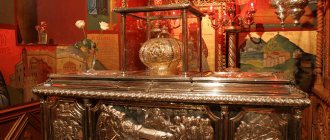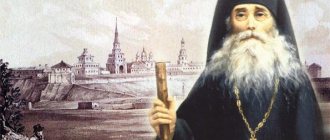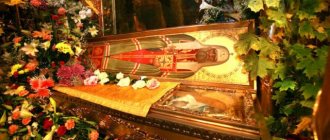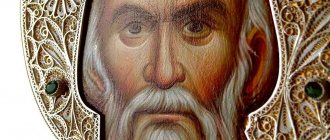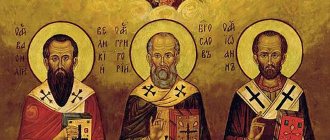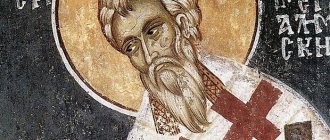| St. Gregory of Nyssa |
Gregory
(c. 332 - c. 395), Bishop of Nyssa, saint. Younger brother of St. Basil the Great Commemorated on January 10 and together with the holy family of Basil the Great (on the Sunday of Epiphany) (Greek)
He was probably born, like his elder brother Saint Basil the Great, in the settlement of Annes or Anis [1]. His birth around 332 and his upbringing coincided with the height of the Arian disputes. Studied in Caesarea. Gregory's first mentors were his brother Vasily and sister Macrina. Having received an excellent education, he was at one time a teacher of eloquence. He studied the philosophy and writings of Origen. Under the influence of his family, he later returned to church service. And although he got married, he led a virginal and ascetic life.
Lacking life experience and a strong character, he unsuccessfully took part in the turmoil over the election of Basil to the See of Caesarea. The brother was dissatisfied, but lovingly accepted the repentance. Subsequently, Vasily considered him unsuitable for responsible assignments, and objected to Gregory being at the head of the embassy to Rome. However, in 371 or 372 he consecrated him bishop of the city of Nissa in Cappadocia.
Saint Gregory was a firm zealot for Orthodoxy and, together with his brother Basil the Great, fought against the Arian heresy, suffering persecution from the Arians, by whom in 376 he was falsely accused of misuse of church property, deprived of his see and exiled to Ancyra. The next year, Saint Gregory was again deposed in absentia by a council of Arian bishops, but continued to strengthen his flock in Orthodoxy, moving from place to place. After the death of the king, Valens (378) was returned to his see and was joyfully received by his flock.
In 379, his brother, Saint Basil the Great, died. Saint Gregory grieved the loss of his mentor. He wrote a funeral homily for him and completed the description of the six days of creation, the so-called Six Days, compiled by St. Basil.
In the same year, Saint Gregory participated in the Council of Antioch against heretics who did not honor the immaculate virginity of the Mother of God, and others who worshiped the Mother of God as a Divinity. He was elected by the Council to review the churches in Arabia and Palestine and establish the Orthodox teaching about the Most Holy Theotokos. On his way back, Saint Gregory visited Jerusalem and venerated the Holy Places. In 381, Saint Gregory was one of the main figures of the Second Ecumenical Council, convened in Constantinople against the heresy of Macedonius, who incorrectly taught about the essence of the Holy Spirit. At this Council, on the initiative of St. Gregory, the Nicene Symbol was supplemented. In the imperial edict of 381, Gregory was included in the list of bishops with whom communication is mandatory for recognition as Orthodox.
Together with other bishops, Saint Gregory confirmed Saint Gregory the Theologian in the rank of archpastor of Constantinople. In 383, Saint Gregory of Nyssa was a participant in the Council in Constantinople, where he spoke a word about the Divinity of the Son and the Holy Spirit. In 386 he was again in Constantinople, and he was tasked with delivering the funeral oration for the deceased Queen Plaquilla. In 394, Saint Gregory was again present in Constantinople at the Local Council, convened to resolve church affairs in Arabia.
Saint Gregory of Nyssa was a fiery defender of Orthodox dogmas and a zealous teacher of his flock, as well as a merciful and compassionate father of his flock, their intercessor before the judges; He was distinguished by generosity, patience and peacefulness.
Having lived to a ripe old age, Saint Gregory of Nyssa died peacefully, shortly after the Council of Constantinople. Together with his great contemporaries, Saints Basil the Great and Gregory the Theologian, Saint Gregory of Nyssa had a significant influence on the church life of his time. His sister, Saint Macrina, wrote to him: “You are known to cities, national assemblies, and entire regions: the Churches send and call you for help.” Saint Gregory went down in history as one of the most prominent theologians and figures of Christian thought of the century. Possessing a deep philosophical gift, he understood philosophy only as a means for deeper penetration into the true meaning of Divine revelation.
Curriculum Vitae
Gregory of Nyssa was probably born in 335 in Cappadocia. The saint called brother Vasily a mentor and father, so it is assumed that he was younger than him. Gregory also had a sister who became famous in Christianity as the Venerable Macrina. She was named after her grandmother, who suffered for the Christian faith during the reign of Emperor Galerius.
The mother raised the children, taught them to pray daily and attend church services. The bishop's father died in 341. Biography facts of Gregory of Nyssa:
- received his primary education at the school of Caesarea Cappadocia;
- married the pious girl Theosevia;
- served as a reader at divine services;
- in 365 he was widowed;
- against the backdrop of a passion for ancient literature, he settled in the Pontic monastery, which was founded by his brother;
- became Bishop of Nyssa at the request of Basil, who accepted the rank of Archbishop of Cappadocia;
- helped his brother fight against representatives of Arianism who denied the consubstantiality of God the Father and God the Son;
- following the slander of apostates, he was arrested and sentenced to trial in Ancyra;
- while being escorted to Ankyra, he escaped and wandered for three years;
- returned to Nyssa after the death of Emperor Valens, who supported the Arians, and restored his good name;
- after the death of Basil in 379, he participated in the Antioch meeting against Meletian heretics who did not agree with the policy of appointing bishops;
- under duress, he accepted the position of Metropolitan of Sebaste and led the fight against heresy in Arabia and Palestine;
- at the Second Ecumenical Council in 381, he supported the election of Gregory the Theologian as bishop of Constantinople.
In the capital of Byzantium, St. Gregory of Nyssa as a theologian and preacher. Moreover, the bishop acquired most of his knowledge in his youth on his own and thanks to the lessons of his older brother. Vasily studied in Athens, and Gregory devoted time to self-education after school.
Details of life
Despite the fact that almost all of Gregory of Nyssa’s close relatives became saints, in his youth the theologian was not distinguished by religiosity. Services and prayer chants did not awaken sublime feelings in the soul of the young saint and were a daily duty until an interesting incident happened to him.
A holiday was held in Gregory's parental home in honor of the transfer of the relics of forty martyrs. Tired of listening to prayers, the young man went into the garden and fell asleep in the gazebo. In a dream, he dreamed of paradise, but guards blocked the path to them. The light warriors even wanted to punish the uninvited guest for the intrusion, but one of them persuaded him to let the young man go.
A strange vision prompted Gregory to attend services with great zeal and become a reader. But gradually the spiritual fervor faded. The next shock that set the future bishop on the right path was the death of his wife. Gregory the Theologian spoke of Theosevia as a virtuous woman. The loss forced the young widower to seek solitude in a monastery and faith.
For his fidelity to Orthodox teaching, Gregory suffered as Bishop of Nyssa. The heretical bishops accused the saint of embezzlement of church funds. Since childhood, Grigory has not been in good health. In order not to die from the beatings of the guards, the prisoner decided to escape. But subsequently he experienced infirmities for the rest of his life.
How Gregory of Nyssa spent his last years is unknown, as is the exact date of his death. The saint managed to visit Jerusalem as a pilgrim. But he returned from the Holy Land in a depressed mood and became an opponent of religious travel. Gregory explained his antagonism by saying that changing places does not make God closer.
The bishop founded a new monastery in Nissa, was engaged in its arrangement, writing, and withdrew from theological discussions and church politics. It is also known that the saint again visited Constantinople to participate in a council dedicated to the problems of the clergy of Arabia. After this event, there are no mentions of Gregory of Nyssa, as well as indications of the place where he was buried.
On the way to God
Gregory of Nyssa is one of the most revered Christian saints. The Orthodox Church preserves his memory as the greatest church writer, universal teacher and father.
Despite widespread recognition and countless studies, some important facts of his biography are still presented with the following notes: probably, approximately, possibly. We don’t even know the exact date of his birth or the exact date of death.
By origin, Gregory belonged to a Greek aristocratic family, known not only for its prosperity and social position, but also for its pious principles and righteous life.
This family presented the world with a whole galaxy of saints. During the persecution of the Church, the ancestors of Gregory of Nyssa were persecuted and suffered. At one time, his father’s parents lost their property for confessing the name of Christ. The maternal grandfather suffered martyrdom, and his fortune went to outsiders. The grandmother of Gregory of Nyssa, Macrina the Elder, was a follower of Saint Gregory of Neocaesarea. The main law in her life was the law of God.
Macrina's son, Vasily the Elder, was famous both as a professor of rhetoric and as a virtuous Christian. His wife, the Venerable Emilia, was the daughter of martyrs and from her youth prepared herself for the feat of virginity in Christ. She agreed to the marriage because, being an orphan, she almost became a victim of attackers who encroached on her youth and beauty. God blessed Saint Emelia to become the mother of ten children: six daughters and four sons.
Emilia's desire for virginity was realized in her daughter, Macrina the Younger. One of her sons, Vasily, was glorified by the Church under the name Great. The other, Peter, is glorified as the Saint of Sebaste.
Gregory of Nyssa, born after Basil (the future Basil the Great) and Naucratius (who died under unclear circumstances), became the third son in the family.
According to rough estimates, he was born between 331 and 335. His birthplace could have been either Caesarea or Sebastia. He received the name Gregory in honor of Saint Gregory the Wonderworker.
Gregory's father, Vasily Sr., died early and the entire burden of caring for the children fell on the widow. In addition to his mother, Emilia, the elder sister, Macrina, and the elder brother, Basil (the Great), had a great influence on the upbringing of the future Nyssa saint.
Unlike Vasily, who was educated in the best educational institutions, including in Athens, Gregory studied in local schools. However, through diligence and determination, he achieved the highest level of education.
Activity
Gregory's main task as Bishop of Nyssa and Metropolitan of Sebaste was the fight against infidels. But the philosopher joined the confrontation not out of spiritual impulse, but to first help his brother, and then by imperial decree. During the eradication of heresy, the bishop often fell for intrigues.
Saint Gregory aroused inexplicable hostility among the metropolitan and wealthy nobleman Helladius of Caesarea, who was also declared by the emperor to be the guardian of the purity of the faith in Pontus. Wanting to overcome differences in an honest conversation, the middle-aged and sick philosopher had difficulty finding his opponent’s house in the mountains, where he was celebrating a Christian holiday.
The guards did not let Gregory inside. The saint stood for a long time on the street under the scorching sun. When the weary traveler was admitted to the feast, the owner of the house did not greet him or notice him. Finally, Gregory himself turned to Helladius. But the Metropolitan kicked him out.
Over the years of serving the Church, the saint observed the development of theology and the observance of Christian traditions. He put his conclusions into literary form. Gregory of Nyssa became an outstanding adherent of the doctrine of the Holy Trinity. The Cappadocian saint went down in the history of theology as one of the leaders of traditional Christianity and Christian Platonism, which is based on the idea of the immortality of the soul.
God's calling
Despite the general spiritual atmosphere in the family, sometimes in his youth Gregory allowed himself to treat church life with lukewarmness.
Once, when their family organized a celebration on the occasion of the transfer of the relics of forty martyrs to a chapel deliberately erected for this purpose (in Annisy, on family land), Gregory, instead of participating in the night service, frivolously retired to the gazebo and fell fast asleep. Many warriors appeared to him in a dream. Their appearance was quite menacing. Gregory tried to get to the service he had abandoned, but they did not allow him and were ready to punish him. The situation changed only with the intervention of one of the warriors who appeared, who stood up for Gregory.
Grigory woke up in horror. The judgment of conscience did not take long to arrive. Having mourned his behavior, Gregory immediately went to the urn with the relics, prayed and began to ask God and the holy warriors for forgiveness.
After such heartfelt admonition, he abandoned his hobbies and accepted initiation into a reader. This event is believed to have occurred in 357.
From time to time Gregory visited his brother, Vasily, who labored in Annisy. There he indulged in ascetic work, fasting and prayer, studied the word of God and the works of the fathers.
Creative heritage
The largest work of St. Gregory of Nyssa is a refutation of the apology of Eunomius in twelve volumes. Eunomius of Cyzychos was a Greek bishop and Arian. In his multi-volume work, Gregory refuted his teaching about the other-essence of the Son and Father. The philosopher’s second significant work is “Dialogue on the Soul and Resurrection.” The instruction was written after the last conversation with Sister Macrina.
Gregory learned that the saint was dying upon his return from Constantinople. He managed to talk to his sister before her death. Brother Vasily passed away not long ago. Under the impression of the loss of loved ones, the philosopher wrote a profound work that is useful for every Christian to read. The saint also composed an “Epistle on the Life of St. Macrina,” teaching the life of the sister as an example of high morality and asceticism.
One of the central works of St. Gregory of Nyssa is called the treatise “On the Structure of Man.” The work covers philosophy, natural science and medicine and reveals the following ideas:
- the creation of the world as historically real, and not mythical;
- creations from nothing;
- Divine and natural laws of existence;
- hierarchical order of creation of the world;
- energetic origin of material substances.
In his work, the Bishop of Nyssa points to the union of God and man through love. He also expressed the idea that man finds God within his own nature, and not in the external world. The philosopher called the upbringing of a Christian the endless desire of a person to get closer to perfection.
The writings of St. Gregory of Nyssa are devoted to the following teachings:
- about faith and reason - faith brings the truth-seeking reason closer to God;
- about God, knowledge of God - an important aspect is man’s assimilation to the image of God and cleansing from sin;
- about creation - the concept of creating material from immaterial;
- angelology - according to the author, angels are incorporeal and intangible, but at the same time intelligently thinking beings;
- about the fall of the angels - envy led to the fall of the devil, and evil prevails when good is weakened;
- anthropology - through a person the physical and spiritual worlds are connected;
- protology - initially man was like the angels in spiritual purity and lived carefree in Eden;
- amartology - about the will to choose between good and evil, inclined to the dark side by the recklessness inherent in human nature;
- Christology - Christ is fully both God and man;
- Mariology - the doctrine of the Virgin Mary as the true Mother of God, and not the mother of man, about the preservation of her virginity even after the birth of Christ;
- soteriology - the doctrine of salvation, healing and redemption;
- about church sacraments - about spiritual union with God during baptism and the Eucharist;
- eschatology - about the resurrection of the dead and the Last Judgment.
Saint Gregory also composed 29 sermons. The philosopher wrote in a simple style, so his theological judgments are easy to understand.
Spiritual quest
Some time later, Gregory left the ministry at the temple and got a job as a teacher of rhetoric. Apparently this happened no earlier than 363, since during the reign of Julian, access to this profession was extremely difficult for Christians.
Gregory's act caused a feeling of misunderstanding among his friends. Gregory of Nazianzus, trying to reason with his friend, sent him a letter in which he outlined his sadness.
Most likely, it was during this period or somewhat earlier that Saint Gregory entered into marriage with Theosevia. We know almost nothing about the details of their marital union and about Theosevia herself. In a consoling message to Gregory of Nyssa on the occasion of her death, dated 385, Gregory the Theologian spoke of Theosevia as a performer of the Divine will, a faithful daughter of the Church, an adornment of Christ. In addition, he noted his closeness to her through spiritual kinship.
There is an opinion that at some stage of her married life, Theosevia, by agreement with Gregory, entered into monasticism. According to another point of view, she was never Gregory’s wife, but lived with him as a sister. At some time, Gregory, driven by the desire for ascetic deeds, joined the monastic community organized by his brother, Vasily.
Veneration of the saint
Gregory of Nyssa is revered in the Orthodox and Catholic churches. The saint's feast day is January 10. Particles of the relics of the saint are kept in the Greek and Athonite monasteries: Esphigmen, St. Panteleimon, St. Stephen and Nicholas the Wonderworker.
The Life of Gregory of Nyssa was compiled by an anonymous author. Gregory the Theologian dedicated the “Word” to the saint. Also, “Praise” was composed for him, presumably by John Chrysostom. A 9th-century work by Michael Psellus tells of Gregory of Nyssa as part of a Cappadocian circle.
In the work “Homilies” Gregory the Theologian placed joint portraits of the brothers Gregory and Vasily. The Bishop of Nyssa was depicted in menain cycles. In the Russian Orthodox Church, the saint was not widely glorified and churches in his honor were not consecrated.
Lyrics
The liturgical praise of the Cappadocian saint is mentioned in 10th-century sources. A service was read to Saint Gregory of Nyssa, which was common with the Monk Dometian. The observance of the bishop included the troparion, kontakion, luminary and self-concord. The chants were part of the rites after the celebration of Epiphany. Nowadays Saint Gregory is glorified on Memorial Day with three main prayers.
Troparion
- God our father, always deal with us according to Your meekness, do not leave Your mercy from us, but through their prayers guide our belly in peace.
Kontakion
- With the eye of your soul, vigilant and vigilant, you appeared to the saint as a shepherd, and with the rod of your wisdom, and with your warm intercession, you drove away all the evil ones, like wolves, keeping the flock harmless, Gregory of all wisdom.
